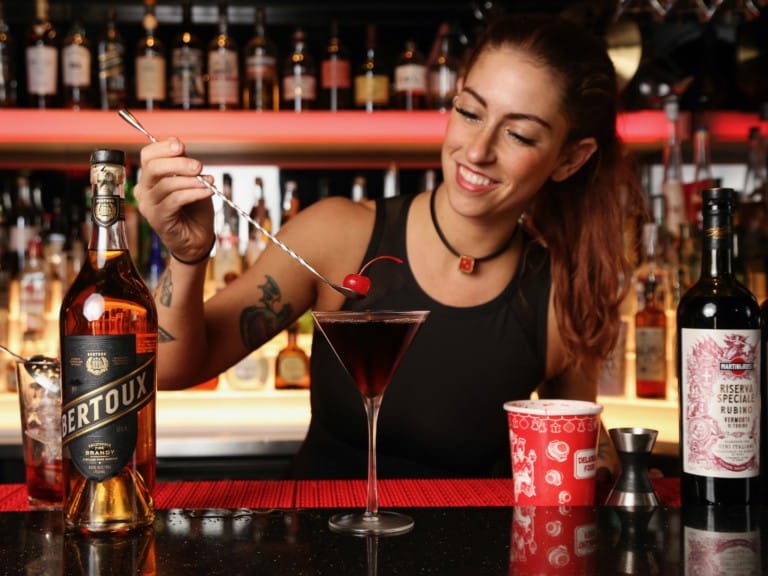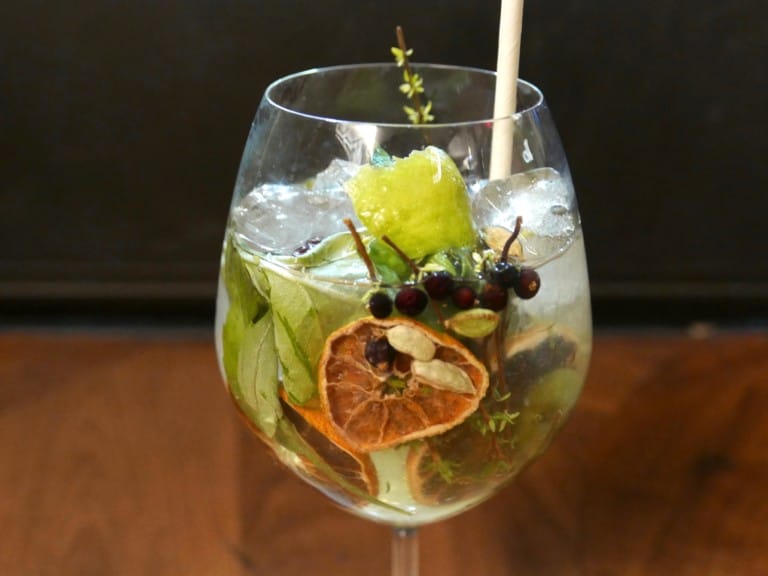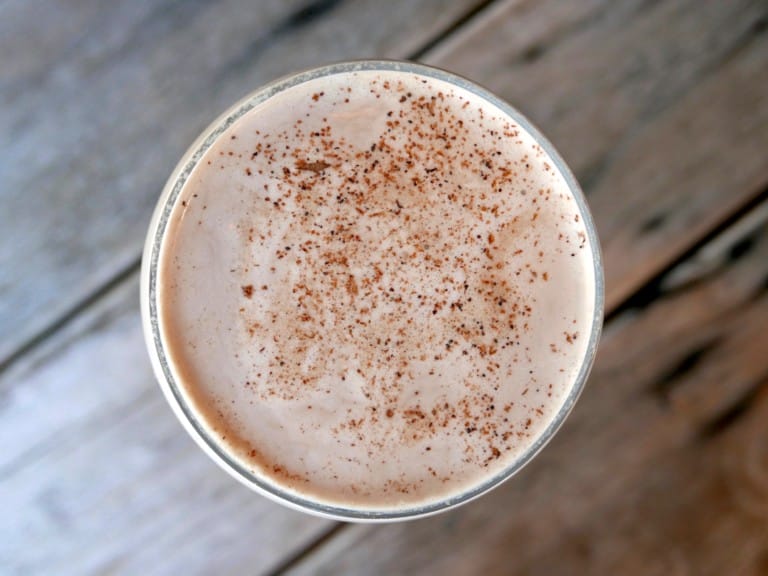Naren Young started young, studying cocktails in his teens and later writing about his Sydney bar experiences for a local publication called Large. He now lives in New York City, where he complements journalism with a high-profile job as “The Cocktail Guy” for AvroKo Hospitality Group, which owns and operates PUBLIC, The Daily, Saxon + Parole and Madam Geneva in Manhattan, and The Thomas and Fagiani’s Bar in Napa. On January 16, we met at Saxon + Parole, and Young shared several spirited insights (and one impressive martini).
Did you always plan to work with cocktails and spirits for a living, or did you consider other careers?
Well, I’ve been a journalist for a long time, for the last 17 years, but they’ve always co-existed at the same time, which has really worked out well for me. Because I write about cocktails and spirits for a living, it allows me to study. I spend a lot of my days reading and researching for articles, which also helps for the bar job. If bartending ended tomorrow, I could fall back on that, and vice versa. I’ve always had another career, for a long time, since I was about 18, when I was first published, but for the most part they just co-exist. Besides that, no.
What was that first article that you got published?
I used to write this column in a very small, free magazine in Sydney called Large, which was a social column about me visiting bars.
What do you remember about your very first night behind a bar?
At that time, I think we were making piña coladas. People were doing a lot of blended drinks. Because I’d studied cocktails and spirits for so long before I worked in a bar, I knew what all the bottles were, but I’d never mixed them that much, except for making drinks for my mom. When she had friends over, I’d make up stuff like strawberry daiquiris in the blender, and whatever I could get my hands on. I’d throw bottles around the back garden, trying flair and just being an idiot…I couldn’t tell you the exact first night, but it was along those lines. .
What was the first venue that you worked at?
The first venue was a café/bar called the New Orleans Café in Sydney. It was owned by a guy from New Orleans, so they had a lot of live New Orleans bands playing. It was busy, but each place I worked just got better and better every time. After that, I went to a pub in another part of Sydney that was famous for a lot of tourists. Each bar just progressively got a bit better, finally working up to some of the best bars in the world.
What brought you to New York?
It was just time for a change. This is the pinnacle of bartending, I guess, to be in New York and try and make it here, so you know, I worked in Sydney and London for a long time, it was just time to try to cut my teeth in this market. So yes, that was the reason.
What was your first opportunity in New York?
PUBLIC, which is a sister restaurant down the street, which I worked at for about a year and a half, in 2006. And then left that company, went on to work at a bunch of other places, now I’m back with that company again. It’s kind of come full circle.
What are the differences and similarities between the programs that you’re running?
They’re all fairly different, I mean there are some underlying similarities across all of them, but I think the way I approach beverage programs is also determined by location and also the demographic we get. So, I guess one of my strong points is being able to identify who comes to our places, and then what we offer them in that place. It’s kind of determined a lot by that.
For instance, up here at Saxon + Parole, we have a very acute focus on very fresh savory drinks. We use a lot of vegetables…We have the fresh juice program, which everyone says they have, but we actually don’t carry any juices unless we squeeze them ourselves. So there’s no cranberry juice here, everything’s squeezed fresh daily, whether it’s fennel juice, carrot juice, beet juice, celery, bell pepper. So there’s a lot of savory drinks going on, using a lot of salt vinegars. In all the cocktail programs we do, I try to have some sort of underlying classic focus, so it’s not like a geeky cocktail bar. This isn’t a speakeasy. We’re on the Bowery here. It’s very busy, we get a lot of foot traffic, you know, and a different crowd than you might get at a PDT or a Pouring Ribbons, or you know, these wonderful, smaller cocktail bars, where their style of service is a bit more attentive. This is a crazy place, it gets really busy, so the cocktails here have to be very fast, very quick. I like to think of them more as crowd pleasers, so I like to have names that are familiar to people, with little twists. There might be some sort of Gimlet, some sort of Collins, it might be some sort of Smash, Julep, Cobbler…I try not to have anything too cryptic or I guess, esoteric.
Down the street at PUBLIC, it’s kind of similar but maybe on a smaller scale. We don’t have the space there or the back-up staff to be able to be doing all these crazy juices. Here we make our own tonic, our own ginger beer, we pickle our own onions, we try to do everything we can ourselves. Down the street we don’t have that luxury, so same philosophy, on freshness, but smaller cocktail menu, and that restaurant has a Michelin star, so drinks – I still keep them elegant – but it’s not as high-paced of an environment down there as it is up here.
The Daily is a very unique experience because the menu changes every day, and that was a concept that I came up with when we opened…I thought to myself if a chef can change the menu every day then why can’t a bar? So it is definitely a unique offering that I don’t think I’ve ever seen in any other bar maybe in the world, that we have five or six drinks every day, they’re all very classic focused, and when possible we run off a Rolodex of about 600 cocktails, that’s how we choose them, so that’s a very unique experience. That’s a loud rock and roll bar, but we have an acute focus on classic drinks.
Madam Geneva next door, that’s more like a small gin den, so that’s very focused on gin. We have 60 or 70 gins, it has very much of an Asian inflection in there, so most of the drinks have some sort of Asian twist or ingredient in them…We’re about to relaunch that venue and make it more of a serious gin bar where there’s a lot more close focus on classic gin drinks, great martini service, and just the evolution of the martini page, tracing the martini from 1860’s up until now, so just making it a bit more of the great gin bar it probably should have been for awhile.
Then Napa Valley, that part of the world is very bountiful in its produce, so the drinks there will be much more in line with Saxon + Parole. A lot of savory drinks, a lot of beautiful, fresh, elegant, session drinks. I want to have drinks or beverage programs that are very sessionable. I want people to be able to sit here and drink three, four, five, six cocktails and not feel drunk or like their palate is shot. That’s a big focus of mine, not have people feel that experience, as opposed to a lot of bars you go to, where drinks are super strong and you might have one or two and you’re drunk. You might go out to dinner and not remember what you did or what you had, and your palate’s gone. My big focus is to make ourselves profitable, and a big way to do that is to keep people in your venue longer without overloading them with sugar and alcohol.
What about naming cocktails?
Where possible, I try to make the names somewhat familiar. It doesn’t work out like that, but we do have a lot of original cocktails here where we have to come up with the name, but if it has some hallmarks of a classic drink, I’ll try to use that. Like Celery Gimlet, which is one of our best selling drinks. Or there’s a Pomegranate Collins. I’m not too big on those cryptic names where it takes a dissertation or a Power Point presentation to figure out why the drink is called what it’s called. If I go into any bars and no one recognizes any of the names, and it takes too long to read, and it takes the bartender five minutes just to make the point…
What are you looking for when you’re hiring somebody to work behind your bar, and does it vary from venue to venue?
I don’t think it varies from venue to venue. I’m looking for people, first and foremost, that have a great sense of hospitality, more than anything. That’s something that’s very hard to teach. I like people with some sort of experience. At any of our venues, because we’re working at such a high level of execution and excellence, I need people to be at least at a certain base level. They don’t have to be cocktail geeks or world experts, but it helps if they have some sort of good base. It could be the bar they worked at, or maybe I know the person they worked for. If they have personality and hospitality, first and foremost, and then there has to be some sort of innate sense in them. After that, all this other stuff, I can teach. The stirring and the shaking, because we do an obscene amount of training here, probably more than any other bar I’ve ever seen. We do, once, sometimes twice a week, which is pretty intense. I expect a lot out of the guys, but that helps the guys get up to a certain level. Personality, hospitality first, and then all the other stuff, knowledge, technique, that stuff can come.
What would you like to be known for as a bartender?









Leave a Comment